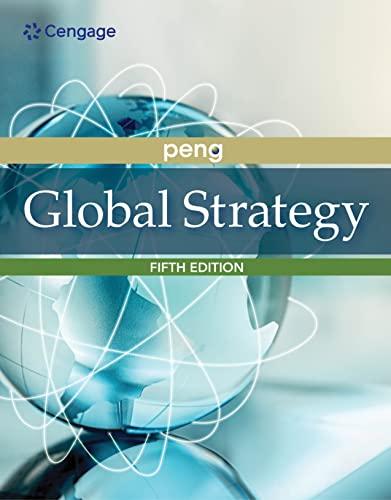The year 2009 was one of the most tragic years in the history of the US automobile
Question:
The year 2009 was one of the most tragic years in the history of the US automobile industry: two of the Big Three automakers, GM and Chrysler, went bankrupt. However, there was one glimmer of hope: Fiat was the “white knight” who came to Chrysler’s rescue. Chrysler had recently gone through a traumatic divorce with Daimler in 2007.
At that time, nobody wanted Chrysler, which was pulled down by deteriorating products, hopeless finances, and the Great Recession. Its desperate calls asking GM, Honda, Renault-Nissan, Toyota, and Volkswagen to help went nowhere.
Only Fiat answered the call with $5 billion as a strategic investor. As the “new Chrysler” emerged out of bankruptcy, the US government (which spent $8 billion to bail out Chrysler) had 10% of equity, the Canadian government 2%, and the United Auto Workers (union) 68%. Although Fiat only had 20%, clearly, as the senior partner in this new alliance, it was calling all the shots.
While Chrysler got itself another European partner, Fiat itself was a weak player. Would the relationship work? The DaimlerChrysler marriage consisted of a luxury automaker and a working-class truck and SUV maker, which had a hard time working together. The Fiat-Chrysler alliance at least consisted of two similar mass market operations.
Both offered each other a set of complementary skills and capabilities. In addition to cash, Chrysler needed attractive small cars. Fiat supplied Chrysler with its award-winning Alfa Romeo Giulietta small car and its excellent smallengine technology that would comply with the increasingly strict fuel-economy standards in the United States. In 2013, while Chrysler’s US factories were running at nearly full capacity, only 40% of the capacity of Fiat’s Italian factories was being utilized. Thanks to Italian politics, Fiat could not close any major factories. Therefore, Fiat needed novel models from Chrysler to make them in Italy. Fiat recently assigned Chrysler’s brand-new Jeep Renegade SUV to be built in Italy. In third-country markets, although each of these relatively smaller players was weak, their odds became better by working together. In Brazil, which is Fiat’s number one market (where Fiat sold more cars than in Italy), Fiat faced major challenges from GM and Renault.
Assistance from Chrysler was valuable. In Asia, neither of them was very strong, although Chrysler’s Jeep models did better. Combining forces allowed them to scale new heights in the tough but important Asian markets.
After several years of experimentation, both sides seemed satisfied with the alliance. Sergio Marchionne, who served as chairman and CEO for both Fiat and Chrysler, was instrumental in making sure both sides worked together. Thanks to their bad experience with Daimler, many American managers at Chrysler used to resent European dominance. This time, as Chrysler owed its existence to Marchionne, its managers tended to give him the benefit of the doubt as he turned Chrysler around. Instead of the more centralized “German” style, Marchionne practiced a more decentralized “Italian” style. He also hired third-country (non-Italian and non-US) executives to help reduce the bilateral cultural tension. By 2011, Chrysler repaid $7.6 billion loans to the US and Canadian governments and bought out the shares both governments held. Overall, Fiat gradually increased its stake in Chrysler, reaching 59% by 2013. In 2014, Fiat acquired the remaining shares and owned 100% of Chrysler via a merger.
Set up in 2014, the merged entity is called Fiat Chrysler Automobiles (FCA), which interestingly is headquartered in neither Turin nor Detroit. Instead, it is registered in Amsterdam, the Netherlands. But FCA’s CEO and the top management team are based in London—its operational headquarters.
Cross-listed in both Borasa Italiana (BIT: FCA) and New York Stock Exchange (NYSE: FCAU), FCA became the world’s seventh-largest automaker. With combined annual output of 4.6 million vehicles, FCA was behind Toyota, Volkswagen, GM, Hyundai, Ford, and Renault-Nissan; but ahead of Honda and Peugeot. This was not bad for the 11th-ranked Chrysler (2.4 million vehicles before the merger) and the 13th-ranked Fiat (2.1 million vehicles). FCA has a broad portfolio of brands such as Alfa Romeo, Chrysler, Dodge, Ferrari, Fiat, Jeep, Maserati, and Ram Trucks. However, confronting the brutal forces of economies of scale in the automobile industry, Marchionne argued that even FCA was not big enough. He openly called for FCA to entertain another megamerger. In short: merge and grow or fade into irrelevance.
Unfortunately, Marchionne passed away in 2018 at age 66. Regarded as one of the all-time stars in the industry, he first rescued Fiat from near-bankruptcy in 2004 and then engineered the alliance with Chrysler in 2009. After nursing Chrysler to health, he successfully merged it with Fiat in 2014. Fulfilling Marchionne’s wish, FCA in 2019 announced a merger with Peugeot SA Group (PSA) of France. Producing 8.7 million vehicles annually, the combined group would become the fourth-largest automaker in the world. On October 31, 2019, the day when the merger was announced, FCA’s shares rose 9.5% and PSA’s 4.5%.
CASE DISCUSSION QUESTIONS
1. From a resource-based view, what does Fiat have in turning around Chrysler that Daimler did not have?
2. Prior to their merger in 1998, Daimler and Chrysler had not collaborated in any alliance relationship. This probably contributed to the eventual failure of DaimlerChrysler.
After Fiat made a strategic investment in Chrysler in 2009, both collaborated in an alliance, which eventually resulted in a merger in 2014. Does FCA have better odds of success than DaimlerChrysler?
3. Will the new FCA-PSA merger be successful?
Step by Step Answer:






